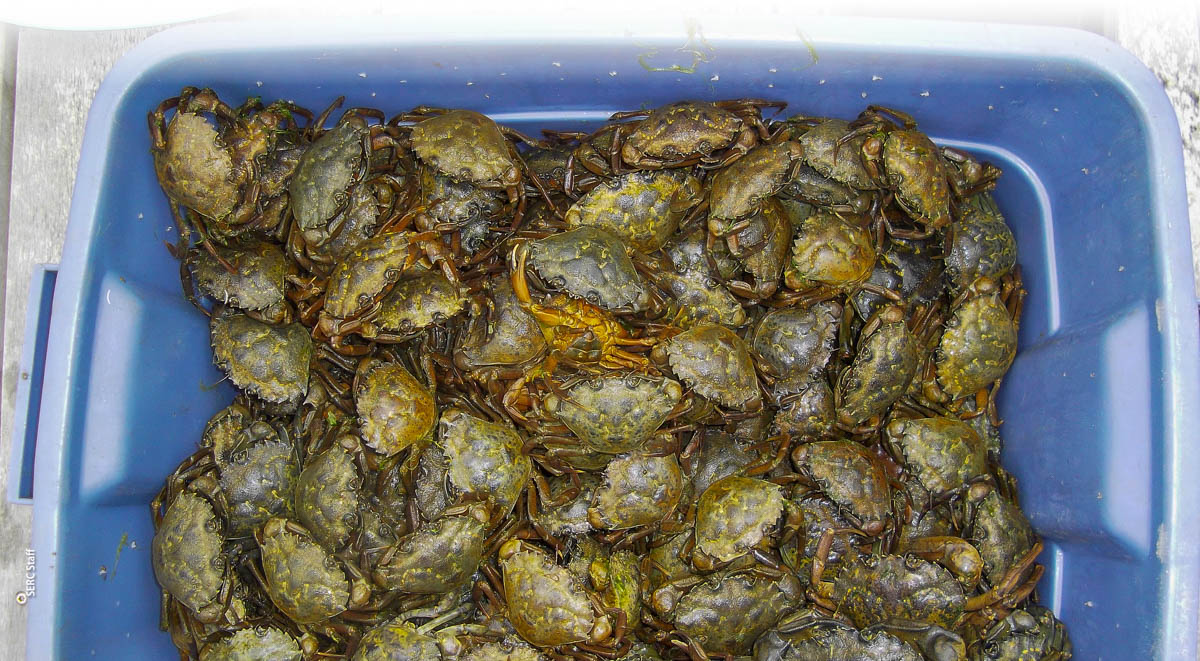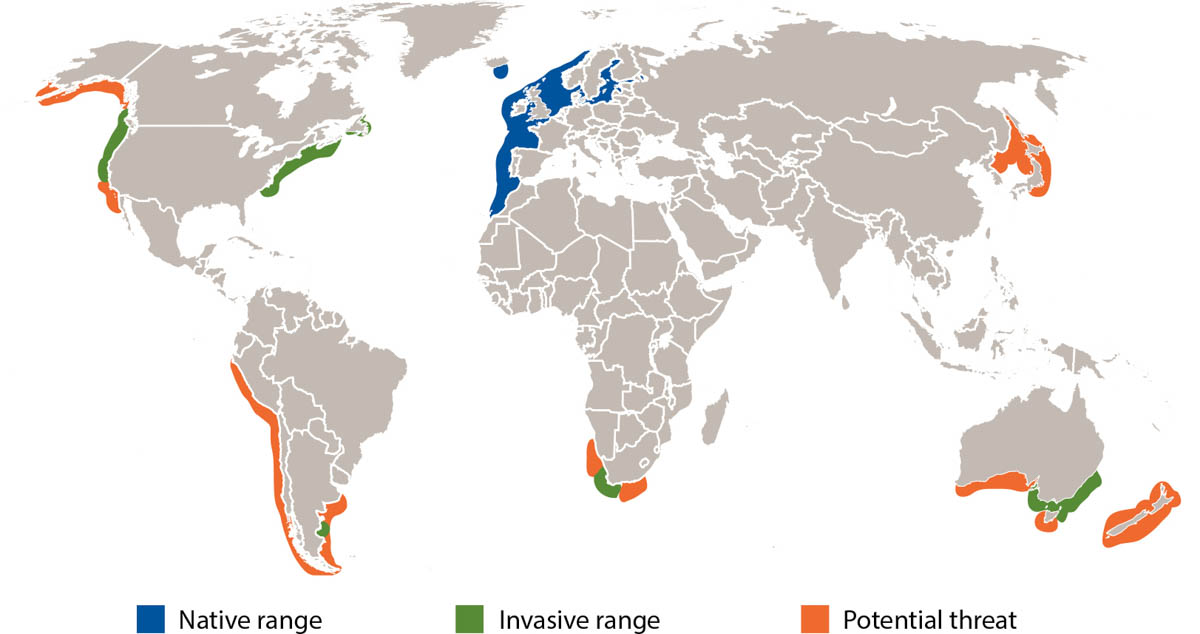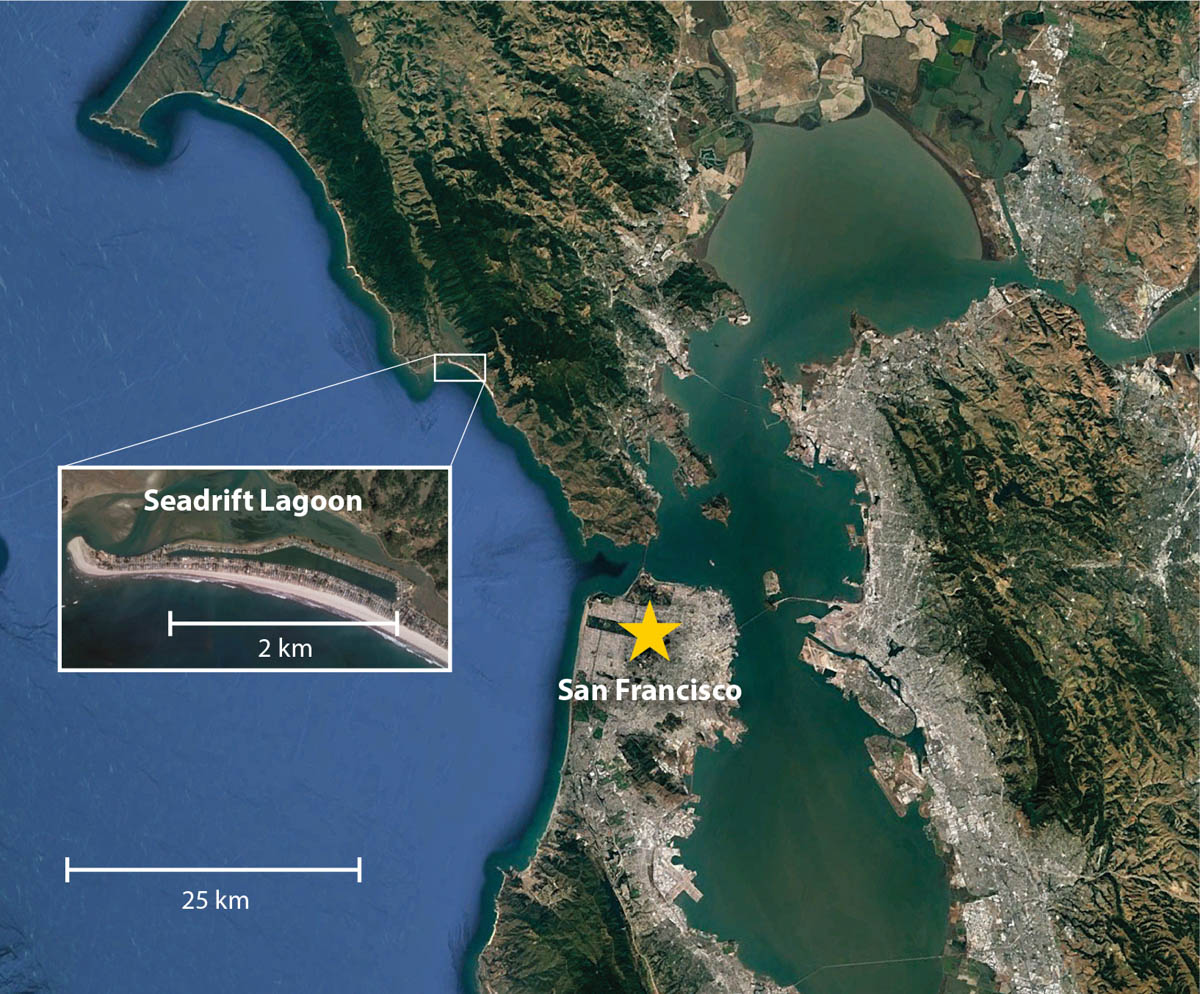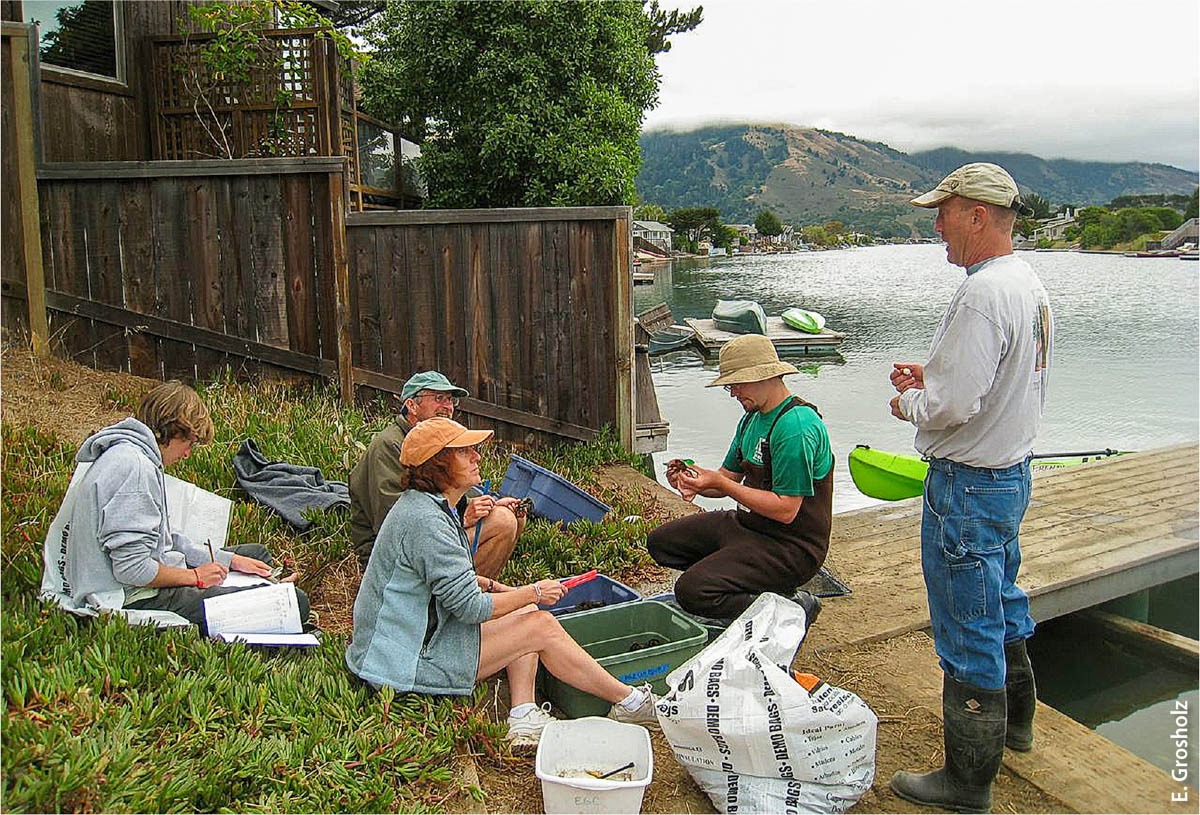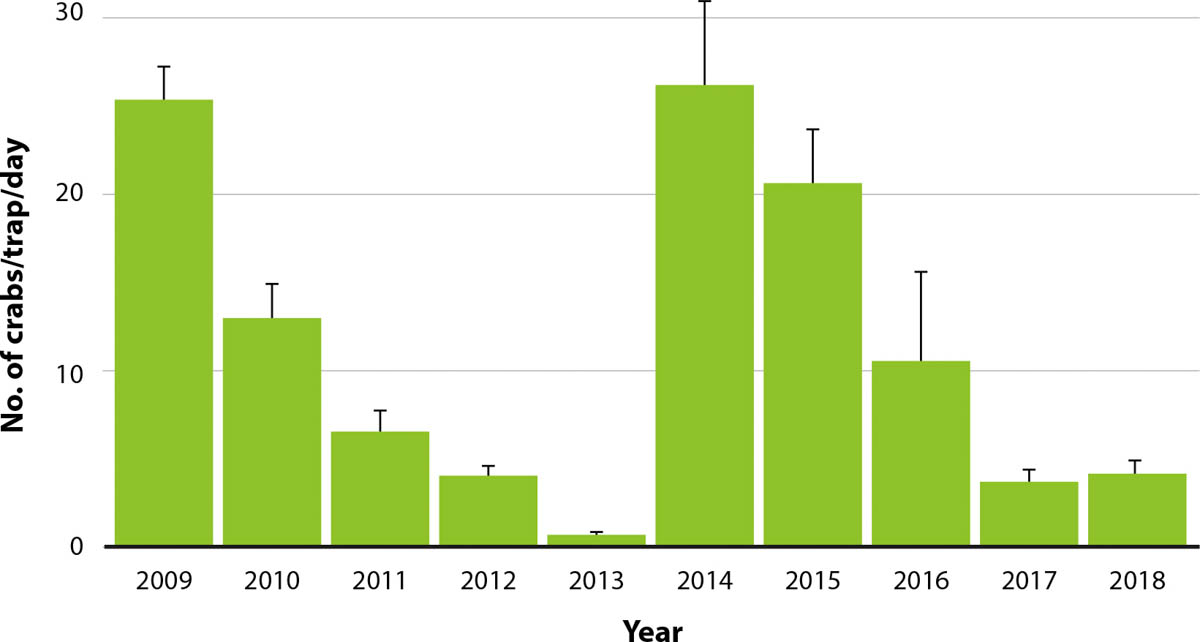All Issues
Engaging the importance of community scientists in the management of an invasive marine pest
Publication Information
California Agriculture 75(1):40-45. https://doi.org/10.3733/ca.2021a0006
Published online March 10, 2021
PDF | Citation | Permissions
NALT Keywords
Abstract
The introduction of nonnative invasive pests is among the many threats facing coastal ecosystems worldwide. Managing these pests often requires considerable effort and resources, and community scientists can be essential for providing the capacity needed for management and monitoring activities. In response to the invasion of a Northern California estuary by the predatory European green crab, a collaborative team of academic researchers and community scientists initiated a local eradication program. The green crab is listed among the world's 100 worst invaders, and threatened both native species and commercial shellfisheries. The program dramatically reduced the green crab population over a 5-year period, but it rebounded, which necessitated a switch in project goals from eradication to population suppression. Community scientists were essential for facilitating this switch by providing the necessary capacity to quantify population characteristics and maintain reduced crab populations. The result was a sustainable program that successfully maintained low green crab densities, which will likely improve habitat for native species.
Full text
Among the many threats to coastal ecosystems around the world is the ongoing introduction of nonnative species — the problem shows no sign of abating, and, for most invasive taxa, introduction rates are increasing (Seebens et al. 2017). The numbers of nonnative species in coastal areas of California, like many similar areas in the United States, continue to grow as the result of human-mediated movements of species from other regions, often by ballast water and hull fouling associated with commercial shipping. Effectively managing invasive species requires consistent monitoring over time and throughout the area of infestation.
Involving community members in monitoring can be a first step toward building capacity for under- or unfunded programs to undertake the kind of large-scale monitoring required to manage the most significant invasions (Johnson et al. 2020). In addition, involvement of community scientists in identifying the arrival of new invasive species or managing ongoing invasions can allow for rapid response, effective monitoring and increased public support for management actions. The application of community science to address invasive species has been shown to be successful for management of plants and pests (e.g., Gallo and Waitt 2011; Meentemeyer et al. 2015).
We use the term community science to describe the process of involving members of the public in scientific research. We eschew the common term citizen science because of the association of citizen with immigration status; we are not interested in the legal immigration status of those individuals we seek to work with. We believe this choice of terminology appropriate for the community science field as a whole, and particularly important for invasive species projects. Invasiveness, like immigration status, is only meaningful in specific geographic contexts. Managing the movement of species outside of their native range, into environments where they may detrimentally impact local ecosystems and thereby become “invasive”, can require global cooperation among peoples in multiple countries. Emphasizing national boundaries through use of the term citizen can deter that kind of cooperation.
The invasive European green crab (Carcinus maenas). The involvement of community members was key to the success of the sustainable management program that significantly reduced the abundance of this crab in a Northern California estuary.
Here we document the successes of, and challenges to, a community science program that was able to address the need for intensive monitoring, public education and engagement, and capacity building for the management of a recent introduction of a nonnative predatory crab. Involvement of community scientists was essential for the success of this program, which has significantly reduced the abundance of this invasive species in a local habitat.
Community scientists participated in a full range of activities from primary data gathering and recording to ongoing project management. This allowed community members to take a more deliberate role in decisions about future actions. The project ran initially as a collaboration among scientific researchers and volunteer community scientists. Over time, it shifted to a program that is now run almost entirely by volunteer community scientists. The efforts of the community scientists have resulted in a sustainable management program, which has reduced the abundance of the invasive crab and will lead to improved habitat for native species.
European green crab on West Coast
The European green crab (Carcinus maenas) has been introduced to several continents around the world (fig. 1). The species was first detected on the west coast of North America in San Francisco Bay in 1989 (Cohen and Carlton 1995). Management concerns began as the crab continued to spread along the coast, north and south from San Francisco (fig. 1). The European green crab has substantially impacted native species in nearby estuaries and threatened to have significant negative impacts on local shellfisheries (Grosholz et al. 2000; Grosholz 2005; Grosholz et al. 2011). A population of green crabs was observed in 1996 (E. Grosholz, personal observation) in the small, semi-enclosed Seadrift Lagoon in Stinson Beach (fig. 2).
FIG. 1. European green crab distribution extends far beyond the native range and is a potential threat to several coastal areas around the globe.
FIG. 2. Map of Seadrift Lagoon, adjacent to Bolinas Lagoon and north of San Francisco, where green crabs were first found in 1996.
The Pacific States Marine Fisheries Commission, a federal agency with authority over fisheries from California to Alaska, was concerned about the potential impacts of the crab's arrival on shellfish populations in the Pacific Northwest and Alaska. With initial funding from this agency, a consortium of three institutions, UC Davis, the Smithsonian Environmental Research Center and Portland State University, undertook a proof-of-concept approach to determine the effectiveness of a small-scale trapping program to remove crabs. The initial goal, from 2009 to 2014, included working with community scientists and was primarily science oriented: to understand the effort needed to reduce or eradicate this isolated population of European green crab.
Engaging community scientists
In the process of planning for the intensive trapping, we realized that we would need additional capacity to manage a network of up to 120 baited traps per day. We were able to engage local volunteers initially recruited from the list of homeowners provided by the Seadrift Homeowners Association. Local homeowners also donated the long-term use of their property, dock and water access to support the necessary field activities. Within a year of the project start, we had engaged a local resource management agency, the Gulf of Farallones National Marine Sanctuary, now called the Greater Farallones National Marine Sanctuary (GFNMS), which had been supporting other nearby restoration programs. GFNMS maintained a substantial list of people from the region who would routinely volunteer their time with local restoration projects supported by GFNMS, including local residents and students from summer camps and schools.
As the program progressed, its goals evolved. In 2014, after 5 years of sustained trapping efforts that had successfully reduced the green crab population to 10% of its 2009 size, there was an explosion of juvenile European green crabs, resulting in a 300% increase in catch per unit effort (see Grosholz et al. 2021). It became clear that eradication was likely not possible, so after 2014 the project focused on suppression of the green crab population. The goal changed to maintaining a small population using a sustainable management program relying on public engagement.
In alignment with the new focus, we increased our efforts to educate community members about the impacts of invasive species such as the European green crab and the possibilities for restoring native fishes and invertebrates. There was also an increased focus on encouraging community members to take a larger role in the green crab removal program. Community scientists were asked to participate in many aspects of the monitoring.
The primary activities of the program involved trapping, which served both a monitoring and a management function. It allowed us to collect data about population dynamics and demography, and served as a method of invasive species management as trapped crabs were removed from the system. In introductory discussions with trapping volunteers, we explained the larger goals of the program as well as recounting past successes and missteps. We described the impacts that European green crab had on local shellfisheries and native species along the California coast as well as the specific impacts in Seadrift Lagoon, so that community members would understand the importance of their participation.
At the start of trapping periods, new program members were shown how the traps were collected, rebaited and redeployed. We trained them in processes involved in data collection by showing them how to (1) distinguish green crabs from native crabs, (2) safely handle crabs that were retrieved, (3) determine sex and reproductive status (females with eggs), (4) distinguish different types of injuries, such as lost claws and legs, (5) measure the size of crabs, (6) identify previously captured crabs, by their clipped spines, and (7) accurately record and check data.
Small female European green crab captured as part of a population wide mark-recapture survey in which crabs are marked by clipping the two right most anteriolateral spines.
Our use of mark-recapture surveys as a method of estimating the size of the crab population was explained. During the weeks when we were conducting those surveys, we instructed community scientists how to mark a captured green crab by clipping pairs of its anterio-lateral spines and how to log its location (trapping station).
All data were collected daily on waterproof data sheets during crab trapping periods, collated, and checked by volunteer coordinators. These data were subsequently transmitted to researchers and underwent a check for quality and accuracy by a seasonal assistant. Data were archived on the UC Davis server and are publicly available.
Eradication failure, 2009 to 2014
Despite a considerable trapping effort, we were unable to eradicate the European green crab from Seadrift Lagoon. However, many of the control and management goals of the project were met. Initially, there was a dramatic reduction of the green crab population in Seadrift Lagoon, from 125,000 crabs in 2009 to < 10,000 crabs by 2013 (Grosholz et al. 2021). That 90% reduction in the population was followed in the spring and summer of 2014 by a dramatic population explosion of the green crab (Grosholz et al. 2021). Using an extensive mark-recapture effort, we estimated the population in August 2014 was > 350,000 crabs, which was more than a 30-fold increase over the numbers in 2013 and nearly triple the population size in 2009 (∼ 100,000), when the removal efforts began (fig. 3).
FIG. 3. Number of crabs captured per trap per day, or CPUE (catch per unit effort), over a standardized trapping period (typically 3 months) at Seadrift Lagoon from 2009 to 2018.
Subsequent studies and population genetic evidence strongly support the idea that this dramatic recruitment of the invasive crab was the result of local population dynamics (Grosholz et al. 2021). Theoretical models of both fisheries and nonnative species management show similar effects of intensive harvest of predatory species. In such harvested populations, there is evidence of unusual reproductive success, more formally known as overcompensation (de Roos et al. 2007). There are, in fact, a few striking examples of introduced species control programs going wrong, like ours. One is the 7-year effort to remove smallmouth bass from lakes in upstate New York, which resulted in greater bass abundance, primarily due to increased juvenile survival (Weidel et al. 2007).
We had inadvertently reduced the population of green crabs to the point where the population control of recruitment by adult green crabs was gone. Normally, adult green crabs would cannibalize most of the newly recruiting juvenile crabs, but now, with most of the adult crabs removed, the newly recruiting juveniles survived to enter the population in record numbers. Documenting this rebound in the crab population derived from the participation of numerous community scientists and local observers. It drew a considerable amount of media attention due to the counter-intuitive outcome.
Sustainable management, 2015 to present
As described earlier, after 2014, we refocused our efforts with the community toward developing a sustainable green crab management program in the Seadrift Lagoon. Many volunteers had heard of the population explosion or witnessed it firsthand and were eager to participate in removal efforts. These efforts have included dozens of volunteers since 2015, with an average of 60 person-hours per week dedicated to trapping, data collection, mark-recapture studies and related activities.
With this much effort, we have been able to reduce the abundance of invasive green crabs. From 2015 until the time of this writing, we have reduced the crab population to 20% to 30% of the 2014 population and maintained it at that level. This level seems a sustainable population size, given the available effort by volunteers; and not reducing the adult crab population below 10% reduces the possibility of repeating the population explosion of 2014. The current sustainable green crab density will likely permit increased colonization by native species and recovery of ecosystem function over time. Maintaining it is only possible through the continued participation of community volunteers in the now annual summer trapping program.
Our program was successful from several perspectives. Many dozens of local homeowners and their families participated in this project over several years. It was also very successful in regard to the quality of the work provided by the community scientists. While retention of volunteers across years remained challenging, we were successful in continuing to engage new participants each year. There are trade-offs between retaining experienced volunteers and engaging support from a larger proportion of the community — in our case, we believe the program benefitted from the latter.
We have data on the volunteer hours for the 2018 and 2019 removal seasons; they show 57 volunteers worked a total of 460 hours removing and recording data on green crabs. The volunteers included 12 children from a nearby summer camp. Several of the 2018 volunteers returned in 2019 to continue to help with the project. The program manager currently has a list of over 40 volunteer community scientists who wish to receive annual announcements on the dates and times of upcoming removal seasons.
The program, and our informal conversations with participants, helped contribute to a better community understanding about European green crab population processes and how to manage the local green crab population long-term. We communicated with participants on a wide range of subjects regarding the ecology of Seadrift Lagoon and the surrounding ecosystem. The project team was engaged in learning as well, as some of our volunteers were knowledgeable and had useful information to share with us about the lagoon and its invertebrate inhabitants.
Education goals
As stated above, over the course of the project, the goal shifted from eradication to suppression of the crab population over the long term. As the goal evolved, we realized how important it was for the community to understand the underlying issues as well as the more immediate goal of project. In other words, our green crab management efforts could benefit from work on two interrelated educational goals: (1) awareness and understanding of our particular project and (2) overall understanding of green crab population dynamics, and more generally the threats posed by marine invasive species.
Our trapping program was visible to homeowners and particularly to seasonal renters, who were among the most numerous community members, and who observed groups of volunteers handling crabs and recording data on docks along the perimeter of the lagoon. Initially, we asked the Seadrift Homeowners Association to distribute information to homeowners and renters by posting signs at entrance and exit gates, and in informational packets dispersed to homes prior to each rental stay. The information alerted people of our activities around the lagoon and emphasized the need to not disturb deployed traps.
The information distribution was not particularly effective in recruiting volunteers, partly because many of the people who received it were there only for a short rental stay. We realized that involving the local homeowners in the process of population control would be a much more effective education tool than just posting a flyer. Despite the considerable time that local homeowners and renters spend on coastal recreation (swimming, surfing, sailing, kayaking, paddle boarding, etc.), multiple informal conversations with homeowners suggested a lack of knowledge regarding the issue of invasive green crabs. Consequently, we expanded our efforts with the assistance of the Seadrift Homeowners Association to increase outreach to community members by participating in Homeowners Association board meetings and public events.
Ultimately, the trapping and population management project proved to be an effective teaching opportunity to show homeowners and renters the impacts of European green crabs and to make them aware of how their own activities could contribute to crab population management. We have not formally quantified this result with before/after survey methods, but informal conversations with homeowners, and other anecdotal evidence, have indicated a significant shift in both their awareness of the problems caused by green crabs as well as their understanding and acceptance of our management activities.
When we began the green crab management program, there were complaints from homeowners to the Homeowners Association regarding our activities. Some homeowners were put off by our presence, and their children enjoyed capturing the very numerous green crabs in one shallow area. However, as the program progressed and we involved more people in the community science activities, they learned and found the idea appealing that their kids would have a greater variety of crabs and other species to capture if we could reduce the number of green crabs. As a result, some households began their own informal management activities, capturing green crabs with makeshift traps and bait.
A significant education opportunity occurred following the media coverage on the crab population explosion. We explained the failed eradication program to the broader community and the need to maintain a low but sustainable population level of green crabs, in hopes of facilitating the repopulation of native species.
Changing role of community scientists
As the goals of the project changed, the role of community members changed as well. The community scientists started to participate not only in the trapping but also in collecting demographic data, including the mark-recapture survey data described above. A few community scientists also took an active role in the data collation and data organization. As of 2019, the project has been managed entirely outside of the academic realm except for the ultimate use of the data. All of the management activities, the trapping, counting and mark-recapture assessments, are now organized by community scientists working in partnership with the program coordinator, Kate Bimrose, and the Greater Farallones Association.
Challenges and lessons learned
Along the way, we learned several important lessons from this project. The first is the difficulty in maintaining a long-term community science program, which became necessary once eradication was not a likely outcome. We learned the importance of being able to recruit new volunteers into the program, and that the recruitment of volunteers was often a function of the effort put into it. As in similar projects (e.g., Gallo and Waitt 2011), we experienced a volunteer fatigue factor; it is often difficult to encourage participation across multiple years. This challenge was addressed by the willingness of the local resource management agencies to devote staff resources toward recruiting new community scientists, and our cooperation with the Seadrift Homeowners Association. In casual conversations with some homeowners, we heard they were participating in restoring or maintaining habitat quality based on their sense of ownership of the area.
The second lesson we learned was the essential role of a volunteer coordinator for projects like ours. Maintaining the trapping surveys requires considerable skill and energy to reach out to volunteers, schedule numerous volunteers throughout the trapping season, coordinate with larger groups like schools and summer camps, maintain trapping equipment and supplies, and so on. A very organized and dedicated person is needed to undertake the responsibilities of organizing these efforts. The current coordinator, Kate Bimrose, participated as a volunteer early in the project and thus had all the necessary project skills and was proficient in data collation and management.
The third lesson we learned was that involving younger community scientists, with school and camp groups, requires preparing more active learning opportunities. We occasionally facilitate these activities by training teachers or camp counselors in the day-to-day work of the trapping surveys.
Although we were not able to eradicate the invasive European green crab from Seadrift Lagoon, we have met the challenge of reducing green crab numbers since 2009. Each trapping season since 2014, the number of green crabs has declined; and we have been able to measure the relationship between trapping effort and population reduction (table 1), a central goal of the project. But with the decline in green crab numbers, the effort needed to remove the remaining crabs increases exponentially. With limited staff and resources, this highlights the necessity of involving local communities in research projects to limit invasive pests.
Community volunteers can expand scientific efforts both in time and space, and increase public knowledge about important environmental issues such as invasive species. Our project demonstrated both the benefits of engaging community scientists as well as the challenges involved in recruiting and maintaining volunteer groups and educating and training the participants. It is our hope that community volunteers will sustain the crab management effort in Seadrift for years to come.



